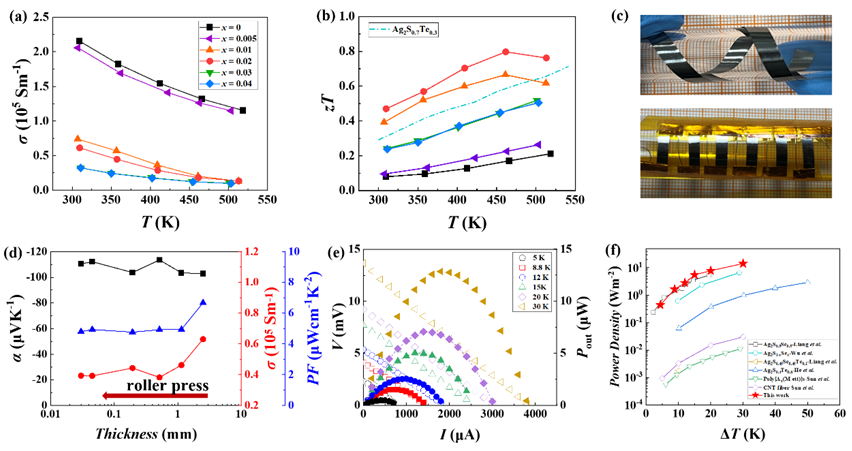Recently, the School of Materials Science and Engineering of Shanghai Jiao Tong University (SMSE, SJTU) has made new progress in the field of inorganic ductile thermoelectric materials. The work is published in Advanced Energy Materials with the title being “High-entropy cubic pseudo-ternary Ag2(S, Se, Te) materials with excellent ductility and thermoelectric performance”. Professor Xun Shi and associate professor Tian-Ran Wei are the corresponding authors. Heyang Chen, a PhD student, is the first author.
Thermoelectric (TE) materials enable the direct conversion between heat and electricity, being an excellent solution to low-grade waste heat recovery, passive power supply, and high-precise cooling. Nowadays, to adapt to the rapid development of flexible/wearable electronics, hetero-shaped and micro-devices, thermoelectric materials should possess not only high TE figure of merit (zT) values but also decent deformability and processibility. However, the traditional high-performance TE materials are inorganic semiconductors showing intrinsic brittleness, which can result in either dramatic failure during service or additional loss in manufacturing.
Silver sulfide (Ag2S), as the first developed inorganic semiconductor with ductility, has poor TE performance near room temperature. On the contrary, the homologous compounds Ag2Se and Ag2Te exhibit decent TE properties with brittle mechanical properties. The pseudo-binary Ag2(S, Se) and Ag2(S, Te) systems have been widely studied for materials with combined plasticity and TE properties. Specifically, cubic-structured Ag2(S, Te) materials have the advantages of high crystal symmetry for easy slipping, disordered Ag ions for low thermal conductivity and generally absent of solid state phase transition above temperature. Up to now, there remain challenges for expanding the cubic-structured region and illustrating the composition-structure-property relations of Ag2(S, Se, Te) system.

Figure 1 (a) Schematic phase diagram of Ag2Q (Q = S, Se, Te). (b) Calculated configurational entropy ΔS considering the mixture of S/Se/Te at the anion site. (c) Phase diagram of maximum bending strain at room temperature of Ag2S-Ag2Se-Ag2Te system. (d) Phase diagram of room-temperature zT value of Ag2S-Ag2Se-Ag2Te system. (e) Engineering tensile stress-strain curves for Ag2S1/3Se1/3Te1/3 and Ag1.98S1/3Se1/3Te1/3; the optical images are Ag2S1/3Se1/3Te1/3 samples before (left) and after (right) tensile test. (f) Local strain distribution by DIC for Ag2S1/3Se1/3Te1/3 when the engineering tensile strains are 0%, 5%, 15%, 30%, and 45%, respectively.
In this work, using the high-entropy strategy, the authors design a series of pseudo-ternary Ag2S1-2xSexTex, Ag2Se1-2xSxTex, and Ag2Te1-2xSxSex materials. Further, the crystal structure, mechanical properties and TE performance are characterized, the composition-structure-property relations are further constructed. The research illustrates that the cubic crystal structure is highly related to high configurational entropy of materials. Ag2-xS1/3Se1/3Te1/3 compositions, which has the highest configurational entropy, exhibit excellent mechanical properties (tensile strain 60-97%, compress strain over 50%, three-point bending strain over 15%). The digital image correlation (DIC) technique is employed and confirms the strain distribution during tension test.

Figure 2 Temperature dependence of (a) electrical conductivity σ and (b) zT for Ag2-xS1/3Se1/3Te1/3 materials. (c) Twisted 30 μm-thick flexible foil and six-pair in-plane device. (d) Room-temperature electrical conductivity σ, Seebeck coefficient α and power factor PF varying with different rolling thickness. (e) Output voltage V and power output Pout as the function of current I under different temperature differences. (f) Maximal power density with other typical devices as a comparison.
By inducting Ag deficiency, the TE properties of Ag2-xS1/3Se1/3Te1/3 can be optimized. The composition Ag1.98S1/3Se1/3Te1/3 can exhibit the zT value of 0.45 at room temperature and 0.8 at 460 K, which is one of the highest performances among plasticity inorganic semiconductors. Benefited from the excellent shape conformability and ductility, the ingots can be further roller-pressed into thin foils (30 μm) with excellent flexibility. Using the flexible foils, the six-pair in-plane flexible TE device is fabricated, and exhibit the output voltage of 13.6 mV and maximal power of 12.8 μW under temperature difference of 30 K.
This work constructs the relations of composition-structure-plasticity-performance of Ag2S-Ag2Se-Ag2Te system and designs the cubic-structured Ag2-xS1/3Se1/3Te1/3 materials with both excellent plasticity and TE performance. This work will deepen the understanding of the principle of mechanical-electrical-thermal coupling and promote the application in complex structural scenarios for inorganic ductile semiconductors. This study was supported by the National Natural Science Foundation of China.
Reference
Heyang Chen, Chenlu Shao, Shaoji Huang, Zhiqiang Gao, Haoran Huang, Zhenyu Pan, Kunpeng Zhao, Pengfei Qiu, Tian-Ran Wei,* Xun Shi.* High-entropy cubic pseudo-ternary Ag2(S, Se, Te) materials with excellent ductility and thermoelectric performance. Advanced Energy Materials, 2023, doi: 10.1002/aenm.202303473
